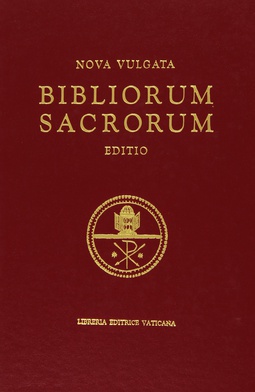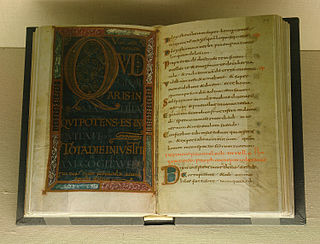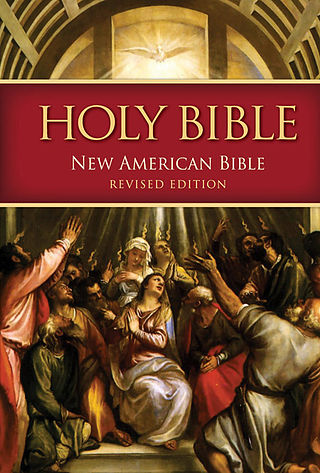
The Roman Missal is the title of several missals used in the celebration of the Roman Rite. Along with other liturgical books of the Roman Rite, the Roman Missal contains the texts and rubrics for the celebration of the most common liturgy and Mass of the Catholic Church.

The Vulgate, sometimes referred to as the Latin Vulgate, is a late-4th-century Latin translation of the Bible.

The Mass of Paul VI, also known as the Ordinary Form or Novus Ordo, is the most commonly used liturgy in the Catholic Church. It was promulgated by Pope Paul VI in 1969 and its liturgical books were published in 1970; those books were then revised in 1975, they were revised again by Pope John Paul II in 2000, and a third revision was published in 2002.

The New American Bible (NAB) is an English translation of the Bible first published in 1970. The 1986 Revised NAB is the basis of the revised Lectionary, and it is the only translation approved for use at Mass in the Latin Church Catholic dioceses of the United States and the Philippines, and the 1970 first edition is also an approved Bible translation by the Episcopal Church in the United States.

Ecclesiastical Latin, also called Church Latin or Liturgical Latin, is a form of Latin developed to discuss Christian thought in Late Antiquity and used in Christian liturgy, theology, and church administration down to the present day, especially in the Catholic Church. It includes words from Vulgar Latin and Classical Latin re-purposed with Christian meaning. It is less stylized and rigid in form than Classical Latin, sharing vocabulary, forms, and syntax, while at the same time incorporating informal elements which had always been with the language but which were excluded by the literary authors of Classical Latin.

The Revised Standard Version Catholic Edition (RSVCE) is an English translation of the Bible first published in 1966. In 1965, the Catholic Biblical Association adapted, under the editorship of Bernard Orchard OSB and Reginald C. Fuller, the Revised Standard Version (RSV) for Catholic use. It contains the deuterocanonical books of the Old Testament placed in the traditional order of the Vulgate. The editors' stated aim for the RSV Catholic Edition was "to make the minimum number of alterations, and to change only what seemed absolutely necessary in the light of Catholic tradition."

A missal is a liturgical book containing instructions and texts necessary for the celebration of Mass throughout the liturgical year. Versions differ across liturgical tradition, period, and purpose, with some missals intended to enable a priest to celebrate Mass publicly and others for private and lay use. The texts of the most common Eucharistic liturgy in the world, the Catholic Church's Mass of Paul VI of the Roman Rite, are contained in the 1970 edition of the Roman Missal.

The Nova Vulgata, also called the Neo-Vulgate, is the official Classical Latin translation of the original-language texts of the Bible published by the Holy See. It was completed in 1979, and was promulgated the same year by John Paul II in Scripturarum thesaurus. A second, revised edition was published in 1986. It is the official Latin text of the Bible of the Catholic Church. The Nova Vulgata is also called the New Latin Vulgate or the New Vulgate.

The Dicastery for Divine Worship and the Discipline of the Sacraments is the dicastery of the Roman Curia that handles most affairs relating to liturgical practices of the Latin Church as distinct from the Eastern Catholic Churches and also some technical matters relating to the sacraments.

The Liturgy of the Hours, Divine Office, or Opus Dei are a set of Catholic prayers comprising the canonical hours, often also referred to as the breviary, of the Latin Church. The Liturgy of the Hours forms the official set of prayers "marking the hours of each day and sanctifying the day with prayer." The term "Liturgy of the Hours" has been retroactively applied to the practices of saying the canonical hours in both the Christian East and West–particularly within the Latin liturgical rites–prior to the Second Vatican Council, and is the official term for the canonical hours promulgated for usage by the Latin Church in 1971. Before 1971, the official form for the Latin Church was the Breviarium Romanum, first published in 1568 with major editions through 1962.
The International Commission on English in the Liturgy (ICEL) is a commission set up by a number of episcopal conferences of English-speaking countries for the purpose of providing English translations of the liturgical books of the Roman Rite, the originals of which are in Latin.
Dóminus vobíscum is an ancient salutation and blessing traditionally used by the clergy in the Masses of the Catholic Church and other liturgies, as well as liturgies of other Western Christian denominations, such as Lutheranism, Anglicanism and Methodism.

There exist a number of translations of the Book of Psalms into the Latin language. They are a resource used in the Liturgy of the Hours and other forms of the canonical hours in the Latin liturgical rites of the Catholic Church.

The term Catholic Bible can be understood in two ways. More generally, it can refer to a Christian Bible that includes the whole 73-book canon recognized by the Catholic Church, including some of the deuterocanonical books of the Old Testament which are in the Greek Septuagint collection, but which are not present in the Hebrew Masoretic Text collection. More specifically, the term can refer to a version or translation of the Bible which is published with the Catholic Church's approval, in accordance with Catholic canon law.

The New American Bible Revised Edition (NABRE) is an English-language Catholic translation of the Bible, the first major update in 20 years to the New American Bible (NAB), which was translated by members of the Catholic Biblical Association and originally published in 1970. Released on March 9, 2011, the NABRE consists of the 1986 revision of the NAB New Testament with a fully revised Old Testament approved by the United States Conference of Catholic Bishops in 2010.
Einheitsübersetzung (EÜ) is a German translation of the Bible for liturgical use in Roman Catholic worship. It is published by the Katholisches Bibelwerk and was compiled from 1962 to 1980 by Catholic theologians with contributions from Protestant theologians. Collaboration was done on the New Testament and the Psalms. The Protestant side withdrew support from a project revising the Einheitsübersetzung in 2005.
The Grail Psalms refers to various editions of an English translation of the Book of Psalms, first published completely as The Psalms: A New Translation in 1963 by the Ladies of the Grail. The translation was modeled on the French La Bible de Jérusalem, according to the school of Fr. Joseph Gelineau: a simple vernacular, arranged in sprung rhythm to be suitable for liturgical song and chant. All official Catholic English translations of the Liturgy of the Hours use the Grail Psalms.
Magnum principium is an apostolic letter issued by Pope Francis and dated 3 September 2017 on his own authority. It modified the 1983 Code of Canon Law to shift responsibility and authority for translations of liturgical texts into modern languages to national and regional conferences of bishops and restrict the role of the Congregation for Divine Worship and the Discipline of the Sacraments (CDW). It was made public on 9 September 2017 and its effective date was 1 October of the same year.

The Revised New Jerusalem Bible (RNJB) is an English translation of the Catholic Bible translated by the Benedictine scholar Henry Wansbrough as an update and successor to the 1966 Jerusalem Bible and the 1985 New Jerusalem Bible.
Scripturarum thesaurus, is an apostolic constitution signed by John Paul II on 25 April 1979, the first year of the pontificate of this Pope; the document promulgates the Nova Vulgata as the official Bible of the Catholic Church.













